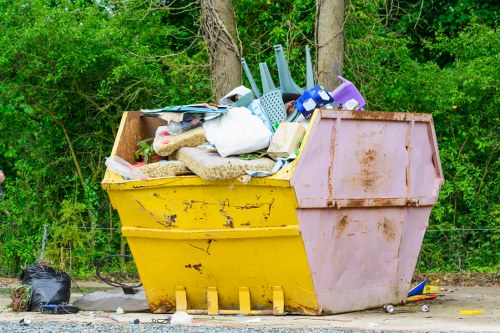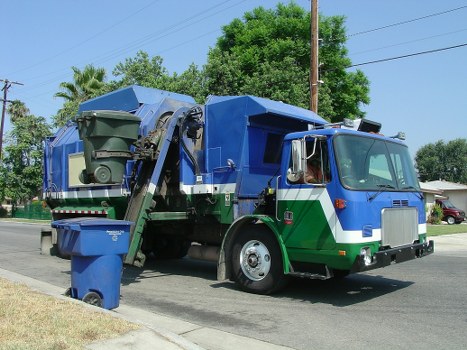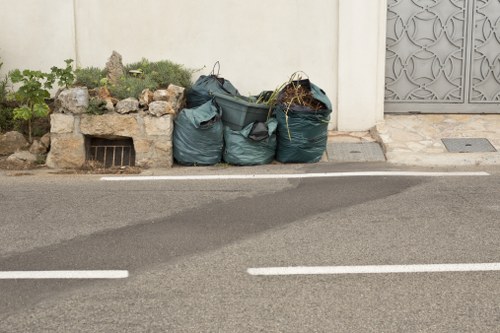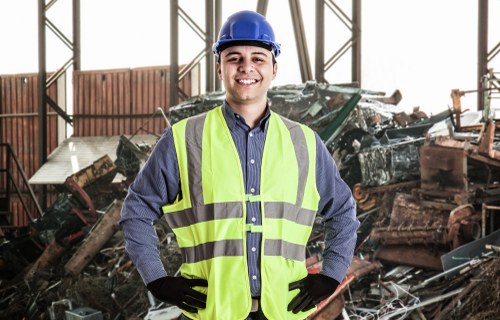Efficient Construction Waste Clearance in Whitechapel

Construction projects, whether large or small, inevitably generate a significant amount of waste. Managing this waste efficiently is crucial not only for environmental sustainability but also for maintaining a clean and safe worksite. In Whitechapel, a vibrant and rapidly developing area, the demand for reliable construction waste clearance services is higher than ever.
Effective waste clearance involves more than just removing debris; it encompasses the entire process of sorting, recycling, and disposing of materials in compliance with local regulations. Proper waste management can lead to cost savings, reduce environmental impact, and enhance the overall efficiency of construction projects.
In this article, we will explore the various aspects of construction waste clearance in Whitechapel, including the types of waste generated, the importance of professional clearance services, and tips for selecting the right provider for your needs.

Understanding Construction Waste
Construction waste refers to any waste material that is produced during the construction, renovation, or demolition of buildings and infrastructure. This includes a variety of materials, each requiring specific handling and disposal methods to ensure safety and environmental compliance.
Common types of construction waste include:
- Concrete and Bricks: These are often recycled and reused in new construction projects.
- Metal: Metals like steel and aluminum can be melted down and repurposed.
- Wood: Untreated wood can be reused, while treated wood must be disposed of carefully to avoid environmental contamination.
- Plastics: Various plastics can be recycled, reducing the need for new raw materials.
- Drywall: This material can be shredded and recycled into new products.

Importance of Professional Waste Clearance Services
Hiring professional construction waste clearance services in Whitechapel offers numerous benefits:
- Compliance with Regulations: Professionals are well-versed in local waste disposal laws and regulations, ensuring that your project adheres to all legal requirements.
- Efficient Waste Management: Experienced clearance services can efficiently sort, segregate, and dispose of various types of waste, saving you time and reducing project delays.
- Environmental Responsibility: Professional services prioritize recycling and proper disposal, minimizing the environmental footprint of your construction project.
- Safety: Proper waste clearance reduces hazards on the construction site, promoting a safer working environment.
- Cost-Effective: Efficient waste management can lead to cost savings by reducing the volume of waste that needs to be disposed of and by potentially reclaiming materials that can be reused.

Choosing the Right Waste Clearance Service in Whitechapel
Factors to Consider
When selecting a construction waste clearance service in Whitechapel, consider the following factors to ensure you choose a reliable and efficient provider:
- Experience and Expertise: Look for companies with a proven track record in handling construction waste. Experienced providers are more likely to offer comprehensive services tailored to your project's needs.
- Range of Services: Ensure the company offers a wide range of services, including waste collection, sorting, recycling, and disposal. Some providers may also offer additional services like site clean-up and hauling.
- Compliance and Certification: Verify that the service provider complies with all local regulations and holds necessary certifications. This ensures that your waste is handled responsibly and legally.
- Recycling Practices: Choose a company that prioritizes recycling and sustainable waste management practices. This not only benefits the environment but can also enhance your project's sustainability credentials.
- Cost and Transparency: Obtain detailed quotes and ensure there are no hidden fees. A reputable company will provide clear and transparent pricing structures.

Evaluating Customer Reviews and Testimonials
Customer feedback is a valuable resource when selecting a waste clearance service. Reviews and testimonials can provide insights into the company's reliability, efficiency, and customer service quality. Look for providers with consistently positive feedback and a strong reputation in Whitechapel.
Additionally, consider asking for references or case studies that demonstrate the company's ability to handle projects similar to yours. This can give you confidence in their capability to meet your specific requirements.
Lastly, assess the company's responsiveness and willingness to address your questions and concerns. Effective communication is essential for a smooth and successful waste clearance process.
Steps Involved in Construction Waste Clearance
Understanding the typical steps involved in construction waste clearance can help you manage the process more effectively. Here is an overview of the standard procedure:
1. Assessment and Planning
Before the actual clearance begins, the service provider will conduct a site assessment to identify the types and quantities of waste generated. This assessment helps in creating a tailored waste management plan that addresses your project's specific needs.
Key Activities:
- Site inspection and evaluation
- Identification of waste types
- Development of a waste management strategy
2. Waste Collection and Sorting
The next step involves the systematic collection and sorting of waste materials. Sorting is crucial for maximizing recycling and proper disposal. It involves separating recyclable materials from non-recyclable ones and categorizing waste based on type and disposal method.
Key Activities:
- Collection of waste from the construction site
- Segregation of recyclable and non-recyclable materials
- Preparation of materials for recycling or disposal
3. Recycling and Disposal
Recycling is a cornerstone of effective waste management. Recyclable materials are sent to appropriate facilities for processing and reuse, while non-recyclable waste is disposed of in accordance with environmental regulations.
Key Activities:
- Transporting recyclable materials to recycling centers
- Proper disposal of hazardous and non-recyclable waste
- Documentation and compliance reporting
4. Site Clean-Up and Final Inspection
After the bulk of the waste has been cleared, a thorough clean-up ensures that the construction site is safe and free of debris. A final inspection verifies that all waste has been appropriately managed and that the site meets cleanliness standards.
Key Activities:
- Final removal of residual waste
- Detailed site clean-up
- Conducting a final inspection
Benefits of Professional Waste Clearance
Engaging a professional construction waste clearance service offers multiple advantages:
- Time Savings: Professionals handle all aspects of waste management, allowing you to focus on your core construction activities.
- Cost Efficiency: Efficient waste handling can reduce overall project costs by minimizing waste-related expenses.
- Environmental Impact: Proper waste clearance reduces landfill use and promotes recycling, contributing to environmental conservation efforts.
- Enhanced Safety: A clean site minimizes hazards, reducing the risk of accidents and injuries.
- Regulatory Compliance: Professionals ensure that all waste is managed in accordance with local laws, avoiding potential fines and legal issues.
Eco-Friendly Practices in Waste Clearance
Sustainable waste management is increasingly important in the construction industry. Implementing eco-friendly practices not only benefits the environment but can also enhance your project's reputation and compliance with green building standards.
Recycling and Reuse
One of the most effective eco-friendly practices is the recycling and reuse of materials. By diverting waste from landfills, you reduce the demand for new raw materials and decrease your project's carbon footprint.
- Concrete and Bricks: Recycled concrete can be used as a base for new construction or in landscaping projects.
- Metals: Metals are highly recyclable and can be reprocessed without loss of quality.
- Wood: Untreated wood can be repurposed in various applications, reducing the need for virgin timber.
Reducing Waste Generation
Proactive measures to reduce waste generation at the source can significantly impact overall waste management. Strategies include:
- Efficient Planning: Careful planning and precise measurements can minimize excess material production.
- Material Optimization: Using materials more efficiently and selecting recyclable options can lower waste levels.
- On-Site Management: Implementing effective on-site waste segregation and handling practices ensures that waste is managed appropriately from the outset.
Green Disposal Methods
Adopting green disposal methods ensures that waste is handled in an environmentally responsible manner. This includes using eco-friendly transportation for waste materials and selecting disposal facilities that employ sustainable practices.
Cost Considerations in Waste Clearance
Understanding the costs associated with construction waste clearance helps in budgeting and selecting the right service provider. Several factors influence the overall cost:
Volume of Waste
The amount of waste generated directly affects the cost of clearance. Larger volumes require more resources for collection, transportation, and disposal, potentially increasing the overall expense.
Type of Waste
Different types of waste have varying disposal requirements. Hazardous or non-recyclable materials may incur higher disposal fees compared to recyclable or less hazardous waste.
Frequency of Clearance
The frequency at which waste is cleared from the site impacts costs. Regular clearance can prevent the accumulation of waste, potentially reducing the costs associated with larger, less frequent removals.
Additional Services
Some waste clearance services offer additional services such as site clean-up, sorting, and recycling. While these services may increase the initial cost, they can lead to long-term savings and enhanced project efficiency.
Location and Accessibility
The geographic location and accessibility of the construction site in Whitechapel can influence transportation costs. Sites that are difficult to access may require specialized equipment or additional time, affecting the overall pricing.
Choosing Cost-Effective Solutions
To manage costs effectively, consider the following strategies:
- Plan Ahead: Proper planning can reduce the volume of waste generated, leading to lower clearance costs.
- Negotiate Contracts: Discuss pricing structures and negotiate contracts to find a balance between cost and service quality.
- Reuse and Recycle: Maximizing the reuse and recycling of materials can decrease the amount of waste requiring disposal, thereby lowering costs.
Regulatory Compliance and Environmental Standards
Compliance with local regulations and environmental standards is a critical aspect of construction waste clearance. Non-compliance can result in fines, legal issues, and project delays. Here are key considerations to ensure compliance:
Understanding Local Regulations
Familiarize yourself with the waste management laws and regulations specific to Whitechapel and the broader London area. This includes guidelines on waste segregation, recycling requirements, and disposal procedures.
Proper Documentation
Maintain accurate records of waste generation, handling, and disposal. Documentation is essential for demonstrating compliance during inspections and audits.
Working with Licensed Providers
Choose waste clearance services that are licensed and certified to handle construction waste. Licensed providers are required to follow regulatory standards, ensuring that your waste is managed legally and responsibly.
Environmental Impact Assessments
For larger projects, conducting an environmental impact assessment (EIA) may be necessary. An EIA evaluates the potential environmental effects of your project and identifies measures to mitigate negative impacts.
Adhering to Sustainable Practices
Implementing sustainable waste management practices not only ensures compliance but also contributes to environmental conservation. This includes prioritizing recycling, reducing waste generation, and using eco-friendly disposal methods.
Innovations in Waste Clearance Technology
The construction industry is continuously evolving, with new technologies enhancing waste clearance efficiency and sustainability. Some of the latest innovations include:
Automated Sorting Systems
Advanced sorting systems use technologies like robotics and artificial intelligence to automatically sort waste materials. This increases the accuracy and speed of the sorting process, leading to higher recycling rates and reduced labor costs.
Waste Tracking Software
Modern waste clearance services employ sophisticated software to track waste from generation to disposal. This ensures transparency, improves regulatory compliance, and optimizes waste management processes.
Eco-Friendly Disposal Methods
Innovations in disposal methods, such as waste-to-energy technologies, convert non-recyclable waste into usable energy. This reduces landfill dependency and provides a sustainable alternative for waste management.
Green Transportation Solutions
The use of electric and low-emission vehicles for waste transportation minimizes the environmental impact of waste clearance activities. This aligns with broader goals of reducing carbon emissions and promoting sustainability in the construction sector.
Smart Waste Containers
Smart containers equipped with sensors can monitor waste levels in real-time, optimizing collection schedules and preventing overflow. This technology enhances the efficiency and responsiveness of waste clearance services.
Case Studies: Successful Waste Clearance in Whitechapel
Examining real-world examples of successful construction waste clearance projects in Whitechapel can provide valuable insights into best practices and effective strategies.
Project A: High-Rise Development
A high-rise building project in Whitechapel required meticulous waste management to handle the large volume of materials. By partnering with a professional waste clearance service, the project achieved efficient waste sorting and recycling, significantly reducing the environmental impact and ensuring regulatory compliance.
Key Strategies:
- Implementation of on-site waste segregation systems
- Regular waste collection schedules to prevent accumulation
- Use of recycled materials in subsequent construction phases
Project B: Urban Renovation
An urban renovation project faced challenges with limited space for waste storage. The chosen waste clearance service provided compact, smart containers and scheduled frequent pickups, ensuring that the site remained clean and operational without unnecessary delays.
Key Strategies:
- Deployment of space-efficient waste containers
- Optimized collection routes to minimize disruptions
- Comprehensive recycling plan to maximize material recovery
Tips for Effective Waste Clearance
Implementing best practices in construction waste clearance can enhance efficiency, reduce costs, and promote sustainability. Here are some tips to optimize your waste management process:
Plan Ahead
Develop a waste management plan before the project begins. Identify potential waste streams, set recycling targets, and establish clear procedures for waste handling and disposal.
Educate Your Team
Ensure that all team members are aware of the waste management protocols. Training staff on proper waste segregation and handling practices can reduce contamination and improve overall efficiency.
Use Design for Waste Minimization
Incorporate design strategies that minimize waste generation. This includes precise material estimation, efficient cutting techniques, and selecting materials with lower waste potentials.
Monitor and Review
Regularly monitor waste generation and management practices. Review the effectiveness of your waste management plan and make adjustments as needed to enhance performance.
Collaborate with Waste Clearance Providers
Maintain open communication with your waste clearance service provider. Collaborate on strategies to improve waste handling and explore opportunities for increased recycling and reuse.
Implement Lean Construction Principles
Adopt lean construction principles that emphasize efficiency and waste reduction. This approach aligns waste management with overall project optimization, leading to better outcomes and sustainability.
Future Trends in Construction Waste Clearance
The construction industry is poised for significant advancements in waste management, driven by technological innovation and increasing environmental awareness. Anticipated trends include:
Circular Economy Models
The adoption of circular economy principles aims to minimize waste by promoting the reuse and recycling of materials throughout their lifecycle. In construction, this could lead to the development of buildings designed for easy disassembly and material recovery.
Advanced Recycling Technologies
Emerging recycling technologies will enhance the ability to process complex and mixed-material waste, increasing the percentage of construction waste that can be recycled and reused.
Integration of IoT and Smart Technologies
The Internet of Things (IoT) will play a crucial role in smarter waste management systems. Sensors and connected devices will provide real-time data on waste levels, enabling more efficient collection and processing.
Increased Focus on Sustainability
There will be a stronger emphasis on sustainability within the construction industry, driving the demand for eco-friendly waste clearance services that prioritize green practices and environmental stewardship.
Government and Industry Initiatives
Governments and industry bodies are likely to implement stricter regulations and incentives to encourage effective waste management. This will foster innovation and the adoption of best practices across the construction sector.
Enhanced Training and Education
Greater emphasis will be placed on training and education for construction professionals regarding sustainable waste management and the latest clearance technologies, ensuring that industry standards continue to improve.
Conclusion
Construction waste clearance in Whitechapel is a vital component of successful and sustainable construction projects. By partnering with professional waste clearance services, adhering to regulatory standards, and implementing eco-friendly practices, builders and developers can manage waste efficiently, reduce environmental impact, and enhance project outcomes.
As the construction industry continues to evolve, staying informed about the latest trends and innovations in waste management will be essential for maintaining efficiency and sustainability. Investing in effective waste clearance solutions not only benefits your current projects but also contributes to the broader goal of environmental preservation and sustainable development.
Contact us today to learn more about how our construction waste clearance services in Whitechapel can support your next project, ensuring a clean, safe, and environmentally responsible worksite.